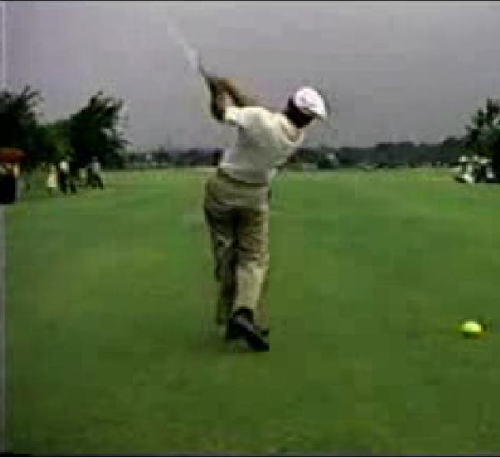I’m going to try to get to some of my thoughts on the face rotation stuff. It’s going to take a while, and I won’t get to all of them today, but I’m going to start- this is for my own benefit as much as it is for anyone who cares to read. I’m pretty certain that it’s not going to be agreed with, but neither agreement nor disagreement is the point, the point is discovery. I don’t mind being wrong, and I may get to the end of my analysis and conclude that I am wrong, but I don’t mind that if it makes for better golf.
While I understand the differences between what’s known as hitting and swinging, I have difficulty with the simplicity of the terms and/or the need to place actions into that either/or state. Ironically, I think the less simplified explanation is actually the simpler way to do it, if that makes any sense. RR gave an explanation about what Peter Senior’s clubface was doing through the zone which would be the generally accepted truth of hitting/swing. I think it’s too simplified, and at the end of the day, not actually very simple at all. It takes unnatural motion and contrived effort to not move while moving, and while in theory, having no face rotation through the zone seems like the simple way of doing it, in my opinion, it’s not. The big thing for me is that there is natural rotation(good), and independent rotation(bad). The independent and bad rotation would the stop flip crap commonly known as swinging- it’s terrible and it can’t actually be taught at the end of the day. It would be kind of like trying to teach someone how to throw two 6’s with a pair of dice- you can teach them how to throw the dice, but after that, it’s all up to chance, so you’re not actually teaching them anything in terms of product. The natural rotation is sequential and is in relationship to the entire motion. The knees rotate further than the shins, the stomach rotates further than the thighs, the shoulders rotate further than the hips. In my opinion, this sequencing continues all the way out to the edge of the system, which is the sweet spot on the club. The more I think about this, the more I realize it’s going to take a long time to get through. Oh well, it can be my project for the next while.
The sweet spot is a spot that just so happens to be on a straight face- this is important to understand for a number of reasons. It’s ultimately the thing that rotates and it’s the thing that we’re trying to bring back to and through the ball in order to move it. It’s not inline with the shaft which is one of the things that both complicates the game, but also gives it an added dimension of power. If it was on the shaft, then we would have a much more linear, blunt force to use. Having it outside the shaft allows us, but also requires us to rotate it. Getting the face shut early retards the sweet spot rotation, and the whole action becomes a sort of push sweep at best, with none of that snap that great strikers have. Again, shut and open are, imo, representative terms. Seeing those things is seeing what Lag calls vapour trails in my view. In order to move and accelerate the sweet spot, the face has to rotate. While the face is rotating and appearing to open and close, the spot is moving through space. Holding the face ‘square’ through the zone, is slowing down the sweet spot. When it ‘closes’ through impact in a naturally rotated and sequential manner(good rotation), the sweet spot is actually traveling through space, in a pretty straight line, it’s even lagging behind in a way. It’s kind of like the CF debate- do things move away from the centre or rotation, or do the just want to go straight when they start moving. It’s interesting to be talking about this because this is the very first thing that I talked to Lag about when I found him on ISG. It was concerning Hogan and how by actively trying to close up the face from open, or to rotate through impact, the acceleration required to do that, actually kept it from closing. It’s a weird chicken and egg, counterintuitive happening, but it happens and is at the heart of how things act in rotation. Are you increasing CF by trying to contain it, or ‘cut it left’? I would say you are, and like Hogan, the more you do it, the more the sweet spot wants to travel straight(depending on which side of the CF debate you’re on)
Is this making any sense to anyone? I feel like I’m getting somewhere, but opening one door leads to another room with loads more doors that all want to be opened, so I don’t want to dig in too deep if it’s not making sense. This is kind of subtle stuff, but, for me, breaking it down and trying to understand it, while sometimes sounding complicated, actually makes things simpler. This is my experiment with thinking in public 
![]()








